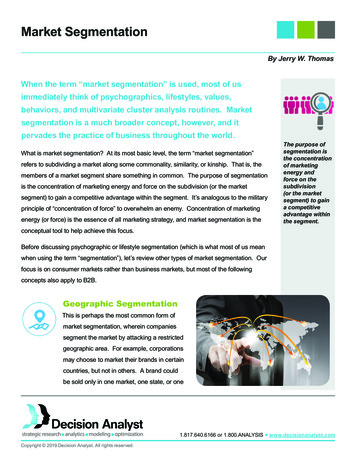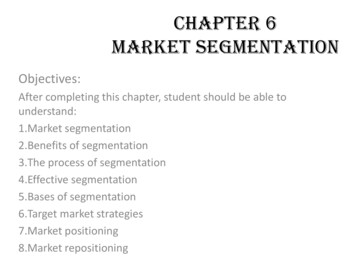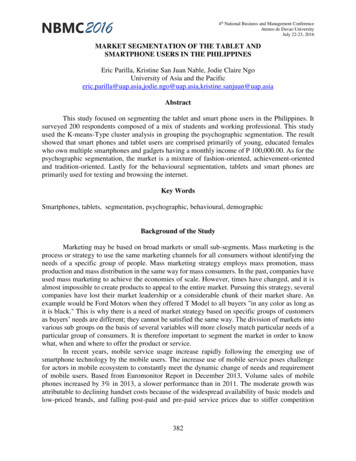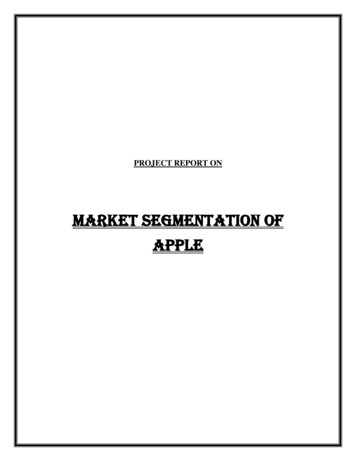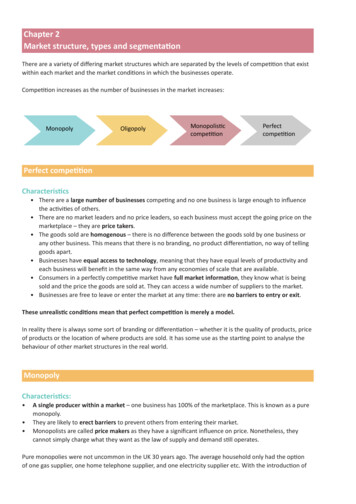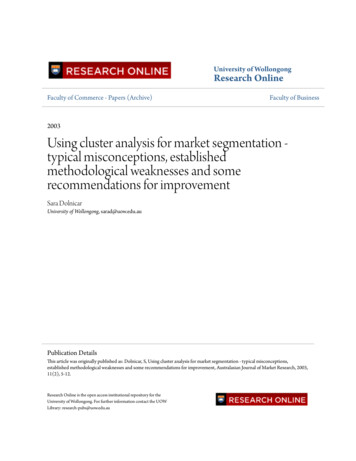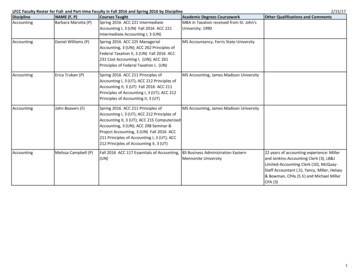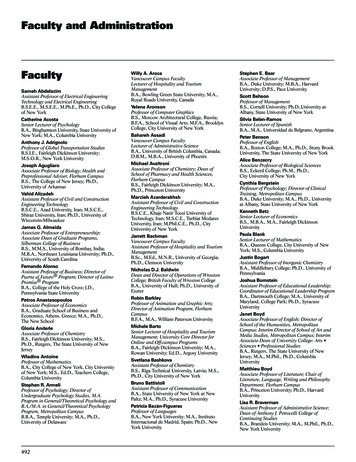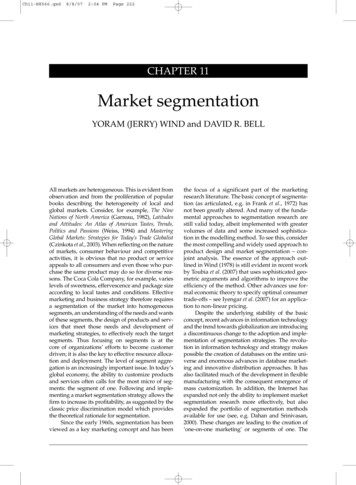
Transcription
Ch11-H8566.qxd8/8/072:04 PMPage 222CHAPTER 11Market segmentationYORAM (JERRY) WIND and DAVID R. BELLAll markets are heterogeneous. This is evident fromobservation and from the proliferation of popularbooks describing the heterogeneity of local andglobal markets. Consider, for example, The NineNations of North America (Garreau, 1982), Latitudesand Attitudes: An Atlas of American Tastes, Trends,Politics and Passions (Weiss, 1994) and MasteringGlobal Markets: Strategies for Today’s Trade Globalist(Czinkota et al., 2003). When reflecting on the natureof markets, consumer behaviour and competitiveactivities, it is obvious that no product or serviceappeals to all consumers and even those who purchase the same product may do so for diverse reasons. The Coca Cola Company, for example, varieslevels of sweetness, effervescence and package sizeaccording to local tastes and conditions. Effectivemarketing and business strategy therefore requiresa segmentation of the market into homogeneoussegments, an understanding of the needs and wantsof these segments, the design of products and services that meet those needs and development ofmarketing strategies, to effectively reach the targetsegments. Thus focusing on segments is at thecore of organizations’ efforts to become customerdriven; it is also the key to effective resource allocation and deployment. The level of segment aggregation is an increasingly important issue. In today’sglobal economy, the ability to customize productsand services often calls for the most micro of segments: the segment of one. Following and implementing a market segmentation strategy allows thefirm to increase its profitability, as suggested by theclassic price discrimination model which providesthe theoretical rationale for segmentation.Since the early 1960s, segmentation has beenviewed as a key marketing concept and has beenthe focus of a significant part of the marketingresearch literature. The basic concept of segmentation (as articulated, e.g. in Frank et al., 1972) hasnot been greatly altered. And many of the fundamental approaches to segmentation research arestill valid today, albeit implemented with greatervolumes of data and some increased sophistication in the modelling method. To see this, considerthe most compelling and widely used approach toproduct design and market segmentation – conjoint analysis. The essence of the approach outlined in Wind (1978) is still evident in recent workby Toubia et al. (2007) that uses sophisticated geometric arguments and algorithms to improve theefficiency of the method. Other advances use formal economic theory to specify optimal consumertrade-offs – see Iyengar et al. (2007) for an application to non-linear pricing.Despite the underlying stability of the basicconcept, recent advances in information technologyand the trend towards globalization are introducinga discontinuous change to the adoption and implementation of segmentation strategies. The revolution in information technology and strategy makespossible the creation of databases on the entire universe and enormous advances in database marketing and innovative distribution approaches. It hasalso facilitated much of the development in flexiblemanufacturing with the consequent emergence ofmass customization. In addition, the Internet hasexpanded not only the ability to implement marketsegmentation research more effectively, but alsoexpanded the portfolio of segmentation methodsavailable for use (see, e.g. Dahan and Srinivasan,2000). These changes are leading to the creation of‘one-on-one marketing’ or segments of one. The
Ch11-H8566.qxd8/8/072:04 PMPage 223Market segmentationglobalization of business expands the scope ofoperations and requires a new approach to local,regional and global segments. Moreover, businesses that have not traditionally embraced marketing in general or segmentation in particular, seeit as imperative for success and even survival.Consider the current enormous effort by the leading financial services firms to understand how tosegment the global at-retirement market fuelled bythe baby boomers in North America and WesternEurope. Finally, it is important to recognize a subtlebut pervasive shift in the bases for segmentation.Historically, marketers segment the market according to characteristics (e.g. demographics), preferences, usage rates, etc. Increasingly, it is difficult tofully articulate a segmentation strategy without anaccompanying discussion of customer lifetimevalue (CLV) and a thought process that makes theCLV calculation explicit (see Gupta and Lehmann,2003).These changes require not only an appraisalof what we know about segmentation, and whatworks and does not work, but also a review of thesegmentation area as part of an entirely new marketing and management paradigm.Therefore, the purpose of this chapter is tointroduce the reader to both the ‘best practice’ inthe segmentation area and the likely new developments. These observations are based on advancesin marketing concepts, marketing science researchand modelling tools, generalizations from empirical studies, successful practices of leading firmsand the conceptual implications of operating inthe global information age. This discussion of thebest segmentation practices and likely advancesencompasses five areas:12345Use of segmentation in marketing and businessstrategy.Decisions required for the implementation of asegmentation strategy.Advances in segmentation research.Impact of operating in the global information ageon segmentation theory, practice and research.Expansion of segmentation to other stakeholders.Thus, this chapter is based on the premise thatsegmentation is the firm’s response to a fundamental market feature – heterogeneity. The likelysuccess (or otherwise) of the firm’s segmentationstrategy is assessed through a segmentation auditdiscussed next. The firm enacts the segmentationstrategy through: (1) data collection, (2) application of models and frameworks and (3) resource223allocation and differential action based on segment (customer) value. The chapter concludeswith a set of critical issues that provide the guidelines for research agenda in this area.Use of segmentation in marketingand business strategyConceptually any business strategy should bebased on understanding, meeting and evenexceeding the needs of target segments. Figure 11.1illustrates the centrality of segmentation and theprogression of fundamental questions to address.At the core is the identification of the existing andpotential customer base, an understanding ofunderlying heterogeneity and the evolving needsand wants of target segments. Next is the responseto segmentation, namely guidelines for the development of products and services, and their associated positioning to meet the evolving needs of thetarget segments. Finally, the product positioningprovides the foundation for the rest of the marketing strategy and the processes, resource allocationdecisions and other activities of the firm.Numerous published and unpublished casestudies attest to the value of segmentation. Forexample, Bell et al. (1998) show how segmentationof store choice decisions of supermarket shoppersreveals fundamental differences in store attractiveness, conditional on a shoppers preferred shoppingstyle. The model illustrates how one store formatcan capture market share from another. It is important to recognize that applications of segmentationcover a diversity of business contexts. In an industrial buying setting, Gensch et al. (1990) providecompelling evidence of the positive consequencesof segmentation of electrical equipment buyers. Ina 1-year test segmentation applied in two of threegeographic districts, sales increased 18 and 12 percent – while sales declined 10 per cent in the districtin which model-based segmentation was notapplied and 15 per cent for the industry. The firmreports continuous market share increases from theapplication of the segmentation approach. This isnot an isolated case. The popular business pressand the conference circuit are full of anecdotal casesin which creative segmentation has paid off. In facta growing number of firms do use segmentation asthe basis of their marketing strategy.Yet despite the general acceptability of segmentation and its value, too many firms are notsegmenting their markets effectively and are not
Ch11-H8566.qxd8/8/072:04 PMPage 224224The Marketing Book1. Who are thecustomers andwhat are theirneeds and wants?2. What product/service offerings willmeet the target segments’ needsand offer us a sustainablecompetitive advantage?3. What strategies and programmes, resources,capabilities, and processes are required todevelop and effectively implement theproduct/service solutions?Figure 11.1 Focus on market-driven strategybasing their strategies on the evolving needs of target segments. The experience of the more successful firms in consumer and industrial markets alikesuggests, however, that effective segmentation is amust. The likelihood of a positive response to thefirm’s offerings is increased, the cost of reachingcustomers and chances of new product and servicefailures are reduced. The need to ‘rediscover’ thecentrality of segmentation is made forcefully in arecent article by Yankelovich and Meer (2006).A segmentation audit can help a firm makean initial determination as to whether it uses aneffective segmentation strategy. We propose threeinterrelated approaches in decreasing order of complexity and time commitment. Table 11.1 presents afairly comprehensive audit template (based on anactual audit for a large computer manufacturer). Inscoring this particular audit it is important to notethat effective segmentation requires a positiveanswer to each question. Any lower score on any ofthese dimensions requires correction.A second approach is the ‘Five Question’ (5Q)method which requires the firm to articulate ananswer to each of the following:1Who are my market segments? This descriptiveapproach forces management to try and first234identity the observable characteristics ofindividuals or firms thought to be in the targetmarket segments.A firm unable to effectivelyanswer this question is likely to have considerabletrouble not only locating existing segments, butalso predicting the evolution of new marketsegments.What do my segments think and feel? Anattitudinal evaluation of segments focuses onpyschographics and underlying segmentpreferences.A firm that cannot develop ananswer to this question is unlikely to be able tocommunicate effectively with target segments.Anunderstanding of perceptions, preferences andattitudes towards the firm and its competitorsare necessary conditions for being able to tailormarketing messages and talk in the appropriate‘language’.How do my segments behave? This questionforces the firm to think about usage, demand andconsumption patterns, and the reaction tochanges in the marketing mix (product, price,promotion and distribution).Where are my segments going? Here, the firmmust attempt to map out the trajectory ofsegment growth. All segments follow a life cycleand this question forces the firm to address
Ch11-H8566.qxd8/8/072:04 PMPage 225Market segmentation225Table 11.1 A segmentation auditPractice12345678910Our business strategies recognizethe need to prioritize target segmentsOur marketing plans include specific plansfor each of the selected segmentsWe have specific product offerings for eachtarget segmentWe have a process for updating theinformation on our segments on anongoing basisOur segments balance the unique country needswith potential synergies across countriesWe have an effective process for implementingsegmentation researchWe have an effective process for implementingsegmentation strategiesWe have P&L reports and accountability bysegmentWe have detailed information about segments,including: Current size of segment Potential size of segment Key business needs of the segment Information systems needs of the segment Their prioritized needs/benefits sought Their prioritized preference for product andservice features Demographic characteristics of thesegments Product/system ownership and usage Competition’s strength in each segment Perceived positioning of each competitorby the members of the segmentInformation about the target marketsegments are incorporated effectively into thefollowing strategies: Positioning Product and service offerings Pricing Promotion Advertising Distribution Sales forceCompletelydescribesusSomewhatdescribesusDoes notdescribeus at allDo notknow
Ch11-H8566.qxd8/8/072:04 PMPage 2262265The Marketing Bookdynamics, and thereby understand long-termviability of segments.What are my individual customers (and segments)worth? This final question stipulates that the firmmust attempt to place a financial value on marketsegments.The inability to answer this question islikely to hamper firm efforts to effectively allocatemarketing resources and maximize marketingreturn on investment (ROI).A third exercise which is less time intensive, butcan nevertheless reveal fundamental strengthsand weaknesses in the current segmentationstrategy is the ‘Product by Segment Matrix’ (PSM).To create the PSM, the firm simply lists as rows ofa matrix, the distinct products and services currently on offer. The columns of the matrix are alist of the segments thought to be addressed bythe firm. At the very least, this exercise will provide some insight into the firm’s view of marketstructure. For example, if all the matrix entries fallon the diagonal, each product is addressing a different market segment. A ‘full row’ implies thatone of the firm’s products is serving the needs ofmultiple segments simultaneously. Such a product is clearly of key strategic importance.Similarly, a ‘full column’ implies the presence of asegment with a deep level of attachment to thefirm’s product line.These three different but complementaryapproaches to the segmentation audit illustrateimportant princi
sons. The Coca Cola Company, for example, varies levels of sweetness, effervescence and package size according to local tastes and conditions. Effective marketing and business strategy therefore requires a segmentation of the market into homogeneous segments, an understanding of the needs and wants of these segments, the design of products and serv-File Size: 540KBPage Count: 23

